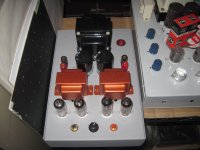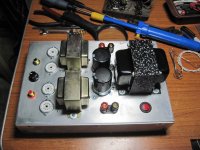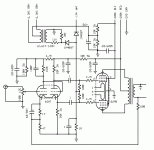No, just simple RC coupled - as simple as it gets... Found Tubelab's post: 6MD8 triple triode utilizing separate bias
It's PP not SE, but requires more tubes.
It's PP not SE, but requires more tubes.
I would have no issue with the concept, but compared to the 6BN11 it has to many disadvantages. Its low gm, relatively low mu, has shared cathodes so cant be set up as garter bias (ease of use) and probably offers lower power.How about the 6MD8? It's a triple triode with shared cathode, use one section as the preamp/driver and the other two sections in parallel for about 1W output into say 8~10k. One tube per channel, I think Tubelab mentioned it somewhere in the forum.
Shoog
shoog hide an lnd150 mosfet as a phase inverter somewhere and use your 6bh11
Already discussed:
If we aim for the last option, a triode antitiode pair then we can consider:
6BH11 Pentode plate current- 12.5 gm- 7.5mA/V dissipation- 2.5W
Triodes Plate current- 13mA gm- 8.5mA/V mu- 46 dissipation- 2.5W.
This offers the option of either putting the pentode up front to generate massive gain for feedback, or a respectable triode driver of a triode-antitriode output.
Shoog
Apples and oranges...I would have no issue with the concept, but compared to the 6BN11 it has to many disadvantages. Its low gm, relatively low mu, has shared cathodes so cant be set up as garter bias (ease of use) and probably offers lower power.
Shoog
Since I already have a E55L SE spud, which has to be the ultimate candidate for the roll, this is purely an exercise in - can a decent PP spud be achieved.Apples and oranges...Garter bias, anti-triode PP vs. simple SE with just one tube.
Still its all educational.
Shoog
829B tube
like 50 listings for it on E-f_rt, I mean E-bay, can't be too rare
http://tubedata.milbert.com/sheets/049/8/829B.pdf
like 50 listings for it on E-f_rt, I mean E-bay, can't be too rare
http://tubedata.milbert.com/sheets/049/8/829B.pdf
Last edited:
I see "it's been there, done that..."
Tiny Daddy by Henderson: 829B or QQV07/40 tube, 6.6K OT Hammond 1650P
Tiny Daddy
http://tubedata.milbert.com/sheets/049/8/829B.pdf
http://tubedata.milbert.com/sheets/129/q/QQV07-40.pdf
http://tubedata.milbert.com/sheets/129/q/QQV07-50.pdf
http://tubedata.milbert.com/sheets/129/q/QQV06-40A.pdf
http://tubedata.milbert.com/sheets/018/g/GU19-1.pdf
http://tubedata.milbert.com/sheets/018/g/GU17.pdf
bias spark (cayin) 929d
Seems rather close to two 6L6's in a bottle. Surprising that someone would make a commercial product around it.
Attachments
Last edited:
but it still needs two more 6SN7's to do the job.
Or an input step-up xfmr.
All this trouble. Just tape two $1 12HL7 together, no input xfmr. needed.
This effort to squeeze two+ tubes into one bottle just makes the amplifier look like some cheap 60's phono amplifier, and it likely will sound that way too if some nutty OT is needed. And then to have to use some odd NOS tubes that won't be available in ten years..... Suggest marketing this in Lunatic Asylums with ET's picture printed on the front panel.
Last edited:
Looks like a ECF80 to me. Nice to know their a Russian equivilant.
Shoog
couldn't be more different ...
ECF80
triode: Pa=1.5W / gm=5 / mu=20
pento: Pa=1.5W / gm=6.8 / mu(trioded)=47
6F12P / 6Ф12П
triode: Pa=3.5W / gm=19 / mu=100
pento: Pa=5.0W / gm=19 / mu(trioded)=100
Hey, there is a product called "water glass", or sodium silicate in water solution. It is used for insulating furnaces. You paint it on and let it dry, it leaves a clear glass "glue".
If it gets too hot however, it foams up like styrofoam (foam glass), forming a high temp insulation.
So now you can take any tubes of your choice, and make them one. Air cooling needed or they poof into foam glass.
Another possibility would be sodium borate, or Borax. This stuff melts into a glass like material at a lower temperature than real glass. Use a propane torch. It "wets" surfaces easily. Commonly used for brazing flux.
Cannot get this stuff wet though, or it dissolves away. Could try mixing the two, no idea what that will do. Maybe I can make my sub-mini tube "IC" this way. Or just pot them in clear silicone.
If it gets too hot however, it foams up like styrofoam (foam glass), forming a high temp insulation.
So now you can take any tubes of your choice, and make them one. Air cooling needed or they poof into foam glass.
Another possibility would be sodium borate, or Borax. This stuff melts into a glass like material at a lower temperature than real glass. Use a propane torch. It "wets" surfaces easily. Commonly used for brazing flux.
Cannot get this stuff wet though, or it dissolves away. Could try mixing the two, no idea what that will do. Maybe I can make my sub-mini tube "IC" this way. Or just pot them in clear silicone.
- Status
- This old topic is closed. If you want to reopen this topic, contact a moderator using the "Report Post" button.
- Home
- Amplifiers
- Tubes / Valves
- Want to build a PP spud.


